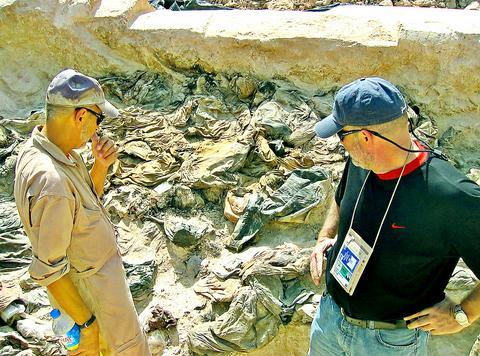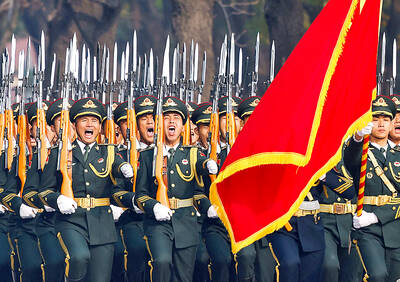Investigators have begun unearthing a mass grave near the village of Hatra in northern Iraq, uncovering more than 100 bodies and seeking evidence to use in a future trial of former Iraqi president Saddam Hussein.
The bodies, believed to be Kurds killed during Saddam's crackdown in 1987 and 1988, are buried in nine trenches, according to Greg Kehoe, an American who works with the Iraqi Special Tribunal, which is preparing the trial of Saddam and his henchmen.

PHOTOS: AP
Kehoe said his team has removed 120 bodies from a trench believed to contain as many as 300 bodies.
He said that because of limited funds and resources, his team can only excavate one mass grave at a time. Experienced European teams, who worked on Bosnian mass graves, are not helping because of their concerns that Saddam could face the death penalty, he said.
"It is my personal opinion that this is a killing field," Kehoe told reporters during a visit to the site south of Mosul. "Someone used this field on significant occasions over time to take bodies up there, and to take people up there and execute them."
Kehoe said the bodies were apparently bulldozed into the graves.
"Unlike bodies that you've seen in many mass graves -- they look like cordwood -- all lined up," he said. "That didn't happen here. These bodies were just pushed in."
He said excavators found the body of a mother still clutching her baby. The infant was shot in the back of the head and the other in the face.
Kehoe said that most mass graves in Bosnia contain largely men of fighting age. Graves near Hatra included many women and children, he said.
"Genocide is the attempt to eliminate, limit or exterminate a religious ethnic national or racial group," he said. "The Kurds are clearly a different nationality. So could it be considered genocide? It could be. Killing, ethnic cleansing, property relocations, all of those were used to try to limit the Kurdish population. What it is fundamentally is downright murder."
Human rights organizations estimate that more than 300,000 people during his 24-year rule, which ended when US-led forces toppled his regime last year.
Saddam is expected to stand trial for crimes against humanity and other offenses next year, but no date has been set.
Meanwhile, coalition personnel mounted two operations last month to rescue members of a group of three hostages held in Iraq, but they didn't find them, a US government official said Tuesday.
British civil engineer Kenneth Bigley and US engineers Eugene Armstrong and Jack Hensley were the targets of the rescue. They were kidnapped from their homes in Baghdad on Sept. 16.
The first operation came before Sept. 20, when Armstrong is believed to have been beheaded by his captors, the US official said, discussing sensitive operations only on the condition of anonymity. The second came after Armstrong's death but before that of Hensley, which was reported Sept. 21.
CNN reported US forces found no signs of the three during either operation.
Bigley's killing was confirmed Sunday. Another US official said there was credible information Bigley tried to escape with the help of one of his captors but was recaptured and quickly beheaded.
Tawhid and Jihad, lead by Jordanian terror mastermind Abu Musab al-Zarqawi, claimed responsibility for the abductions and killings.
More than 150 foreigners have been kidnapped in Iraq, some for ransom and others as leverage against the US and its allies. Bigley was at least the 28th to be killed.

The Ministry of Foreign Affairs (MOFA) yesterday said it is closely monitoring developments in Venezuela, and would continue to cooperate with democratic allies and work together for regional and global security, stability, and prosperity. The remarks came after the US on Saturday launched a series of airstrikes in Venezuela and kidnapped Venezuelan President Nicolas Maduro, who was later flown to New York along with his wife. The pair face US charges related to drug trafficking and alleged cooperation with gangs designated as terrorist organizations. Maduro has denied the allegations. The ministry said that it is closely monitoring the political and economic situation

Conflict with Taiwan could leave China with “massive economic disruption, catastrophic military losses, significant social unrest, and devastating sanctions,” a US think tank said in a report released on Monday. The German Marshall Fund released a report titled If China Attacks Taiwan: The Consequences for China of “Minor Conflict” and “Major War” Scenarios. The report details the “massive” economic, military, social and international costs to China in the event of a minor conflict or major war with Taiwan, estimating that the Chinese People’s Liberation Army (PLA) could sustain losses of more than half of its active-duty ground forces, including 100,000 troops. Understanding Chinese

UNRELENTING: China attempted cyberattacks on Taiwan’s critical infrastructure 2.63 million times per day last year, up from 1.23 million in 2023, the NSB said China’s cyberarmy has long engaged in cyberattacks against Taiwan’s critical infrastructure, employing diverse and evolving tactics, the National Security Bureau (NSB) said yesterday, adding that cyberattacks on critical energy infrastructure last year increased 10-fold compared with the previous year. The NSB yesterday released a report titled Analysis on China’s Cyber Threats to Taiwan’s Critical Infrastructure in 2025, outlining the number of cyberattacks, major tactics and hacker groups. Taiwan’s national intelligence community identified a large number of cybersecurity incidents last year, the bureau said in a statement. China’s cyberarmy last year launched an average of 2.63 million intrusion attempts per day targeting Taiwan’s critical

‘SLICING METHOD’: In the event of a blockade, the China Coast Guard would intercept Taiwanese ships while its navy would seek to deter foreign intervention China’s military drills around Taiwan this week signaled potential strategies to cut the nation off from energy supplies and foreign military assistance, a US think tank report said. The Chinese People’s Liberation Army (PLA) conducted what it called “Justice Mission 2025” exercises from Monday to Tuesday in five maritime zones and airspace around Taiwan, calling them a warning to “Taiwanese independence” forces. In a report released on Wednesday, the Institute for the Study of War said the exercises effectively simulated blocking shipping routes to major port cities, including Kaohsiung, Keelung and Hualien. Taiwan would be highly vulnerable under such a blockade, because it